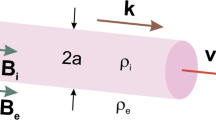Abstract:
Sir James Lighthill has an exceptionally wide range of research interests; one of them is magnetohydrodynamics (MHD). In a major paper (Lighthill, 1959), he considers MHD waves in general, and in particular Alfvén waves with the Hall effect. He analyzes the radiation field using a method of asymptotic estimation of Fourier integrals, which was further developed in subsequent papers (Lighthill, 1964). This method is applied to internal or acoustic-gravity waves in his book on waves in fluids (Lighthill, 1978), which includes an appendix on MHD waves. As an applied mathematician, Sir James was always aware of the applications of his theories; in the case of MHD waves he considered their role in the heating of the solar atmosphere (Lighthill, 1967). In this presentation in honor of Sir James Lighthill, I choose to address the subject of hydromagnetic waves, with application to the solar atmosphere and wind, for two reasons: first it is less likely to be covered by other authors than, say, his better known work on aerodynamics, aeroacoustics, or biofluiddynamics; and I feel a volume in honor of Sir James should reflect his significant contributions to MHD. The second motivation is that about two decades ago, Sir James suggested that I consider magneto-atmospheric waves and their role in the solar atmosphere, and this may be an appropriate occasion to report on what was made of this suggestion. Sir James has a rare ability not only to initiate new areas of research but also to pinpoint subjects ripe for significant development, and this is also substantiated in the field of atmospheric waves. In the present communication paper I consider all three MHD modes (Alfvén, slow, and fast), including viscous and resistive dissipation, cases with external magnetic fields of varying strength and direction (spherical and spiral waves), and the Hall effect and some instances of nonlinear effects; application to the solar atmosphere and wind shows that MHD waves play a major role in energy and mass balance in the solar system. The case of weakly dissipative nonlinear magnetosonic waves relates to another celebrated paper on viscous effects on large amplitude sound waves (Lighthill, 1956). Although I have research interests influenced by, or in common with, Sir James, in other areas, such as aeroacoustics (e.g., Campos, 1986), aeronautics (Campos et al., 1995), and applied mathematics (Campos, 1984a, 1994a), I chose to concentrate on magneto-atmospheric waves and the Sun, as an expression of gratitude for Sir James's inspiring suggestion.
Similar content being viewed by others
Author information
Authors and Affiliations
Additional information
Received 24 January 1997 and accepted 30 May 1997
Rights and permissions
About this article
Cite this article
Campos, L. On Hydromagnetic Waves in Atmospheres with Application to the Sun . Theoret. Comput. Fluid Dynamics 10, 37–70 (1998). https://doi.org/10.1007/s001620050050
Issue Date:
DOI: https://doi.org/10.1007/s001620050050




